
|
 |

|
 |
Epitome of shringara in Kathakali with Guru Sadanam Balakrishnan - Shveta Arora e-mail: shwetananoop@gmail.com Photos courtesy: Sadanam Balakrishnan June 17, 2019 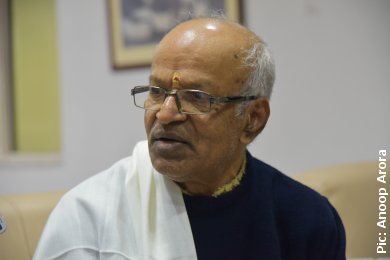 The makeup of the performer is very important for any performance. Kathakali is one dance form that has very distinctive makeup and costuming, which can totally mould the dancer in that character. Here, you see a dancer wearing very elaborate aharyam and the makeup has totally transformed him into the monkey king for the performance. So many aspects of his makeup are remarkable. His facial colours, his eye makeup, the enhancement of his lips and the beard-like mask. This art of makeup is probably as old as the art of Kathakali itself. He goes about moving his very heavy, cumbersome costume and making strange expressions on his face. This is Guru Sadanam P.V. Balakrishnan, one of the most renowned and established exponents of Kathakali today. A respected guru of the dance form for decades, he has added several new plays to the repertoire, written a book on Kathakali, travelled to over 25 countries and trained and guided several younger artists. Among his several awards is the Sangeet Natak Akademi Award (2004). He took over as principal and chief artist of the International Centre for Kathakali in Delhi in 1980 after several years of performing and teaching. We spoke to him about the distinctive makeup in Kathakali, what it's made of, how it's done and how it helps in the performance. Please tell us a little about your journey in your dance form. When I was in class 6, only 11 years old, they started a dance class in school. They asked all those interested to enroll. I raised my hand. Around 40 students came up. I was one of the 5 selected, luckily. The school timings were 10 to 4 and after school, one hour was devoted to dance class. My house was 5 miles away from school and there was no bus or anything, we used to walk. I used to run home. And when my school manager came to know of that, since he was a big landlord, he arranged for my accommodation in his house. In the school anniversary celebrations, there was a small Kathakali item in which I participated. Everybody appreciated my performance, and in the two successive years, in classes 7 and 8, I presented Kathakali at the school event. After that, I changed my school. There too, the same guru came and took class. The school manager thought that I was going to give up school because of some financial problem, but when he came to know of my interest in dance, he arranged for me to join a professional Kathakali school. After that, my academics were discontinued. Then after two years, the Kathakali school manager said, if I was interested, I could continue both. So I finished classes 10 and 11 and I was first in the state, even after Kathakali class. I was offered college, but I was not interested at that time. From 1958 to 1966, I was at the Gandhi Sevasadanam Kathakali and Classical Arts Academy for an eight-year professional diploma course. I had great gurus, including Kondiveetil Narayan Nair, Thekkinkattil Ramunni Nair and Keezhpadam Kumaran Nair. Because of that, I was offered college. After completing that, I went to my village, where I started teaching at Parassinikadavu Sree Muthappan Kathakali Yogam. I applied for the central government scholarship for higher studies from the Ministry of Culture and got it. I joined the Gandhi Sevasadanam again under my guru and got my PG scholarship. Even after that I was nowhere - getting performances was difficult. I joined the school and taught for three years. At that point, it became a big problem for me to continue due to financial problems. At that time, I got the call from the International Centre for Kathakali to teach and perform. This institution was started by Sardar K.M. Panikkar, the famous diplomat at that time, and he was one of the members, first president of this institution, started in 1960. It was stopped for two years because of financial and other problems. In '72 it was not functioning; I joined it in '74. That year, on 26 January, Sirimavo Bandaranaike was the chief guest at the Republic Day parade and I performed before her and Indira Gandhi on 26 January 1974. 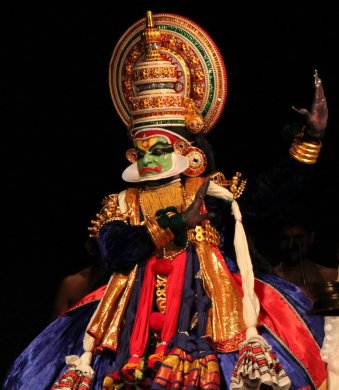
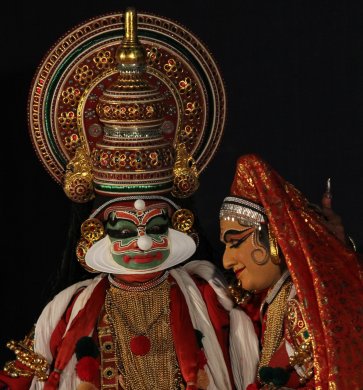
Costume and makeup are very important in Kathakali. Could you please elaborate on the shringara aspect? Yes, we must admit, the first attraction of Kathakali is the costumes and makeup. The layman doesn't know the hand gestures etc., but everybody is attracted to Kathakali because sarvendriyanam nainam pradhanam - the eyes are the most important among the five senses. Kathakali's one advantage is the colourful makeup and costumes, but sometimes they are misused. It is very colourful and so unnecessarily, it is used for advertisements etc. without any sense of the art. I have had so many bad experiences. In Kathakali, the characters are superhuman characters - gods, demigods - and even human beings have superhuman qualities, they are not normal persons. To depict such characters, it needs extraordinary costumes and makeup. For that, the founders of Kathakali had enough inspiration in Kerala. The ritual art forms of Kerala are so rich in colour. Those costumes and makeup inspired them and they developed separate costumes and makeup for Kathakali. They were also influenced by the Natya Shastra, because colours have a definite significance in the Natya Shastra. For example, green is for good, noble characters. Theyyam, Mudiyettu are the local ritual art forms. Theyyam is the most colourful dance form in the universe, according to me. If you see a character - there are over 400 different characters - some are so beautiful... It influenced them, but in Kathakali, there is not that much intricate lining etc. Just to give the effect for the emotions. Just to give the frame inside so expressions will be brighter and clearer. But in Kathakali, the expressions are not lokadharmi. It is totally, totally stylized because the language is stylized, Sankritised Malayalam, very loud and dramatic percussion, stylized way of acting - everything is stylized. The emotion also must be stylized then - when two negatives come together, then it is an original, not artificial. The characters are divided mainly according to their qualities, guna, the triguna - satva, rajas, tamas. First is satva, noble characters like Bhima, Yudhishthira, Shiva, even Shri Rama, all in one group called 'pacha.' Pacha in Malayalam means green. The main colour of makeup for this group is green, with pink lips, black and white around the eyebrows, Vaishnava namam and white border. In that, there are further divisions - e.g., Krishna has a different wig and costume variations, Bhima is different, the headgear will be different too. The next one is rajaguna - powerful, aggressive and sometimes romantic characters, like Ravana, Duryodhana - most powerful anti-heroes are in this group. Very beautiful makeup and costumes of this group, kathi, and the presentation is also very romantic. It became more predominant in Kathakali than even the good characters. Kathi - in the makeup there will be a knife; kathi means knife. There is a knife pattern either on the cheek or on the forehead, and a white nose, to give a little humour to that character. In that also further variations are defined - you cannot make any change. Third is called thaadi - thaadi means 'beard'. But not a beard like Parashuram - it is an extension for the face. It looks like the face extended wider. Thaadi has mainly three groups - red beard, which are the most arrogant, thoughtless, rude, rough characters like cannibals, rakshasas, even Dushasana. In that group, there are also Bali, Sugriva etc. because they are animals, not civilized, but with slight modifications to the makeup. White beard is for characters like the monkey chief Hanuman, who is worshipped, Nandikeshvara etc. Black beard or karutha thaadi is for very primitive, uncivilized forest hunter dwellers, e.g., Shiva's fight with Arjuna dressed as a hunter, that hunter was one such character. Another division is called minukku - 'polished'. All the good and noble heroines of Kathakali will be in this group. There is no mask. There are many variations in this - rishis, Narada, Durvasa - but costumes will be different. Plus, folk characters like fishermen, washermen, charioteer etc. Mainly minukku is female characters. In female, there is another group of demoness - Surpanakha etc - rude characters, fully black, big bosom, ugly look, called kari, which means carbon or black. Another group is called theppu - painting or drawing - which is for animals and birds, Garuda, Jatayu etc. Kathakali costumes are now very costly. Only for one character, nowadays, it costs almost Rs.70,000 to one lakh. For a group, with minimum 15 different costumes, it is normally a huge amount, so individuals have no scope. If I learn Bharatanatyam, I can perform solo, but for Kathakali it is not possible for individuals. In one way it is a drawback, in others, not so. 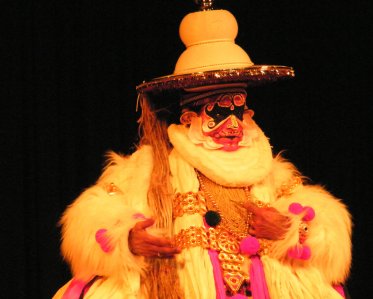
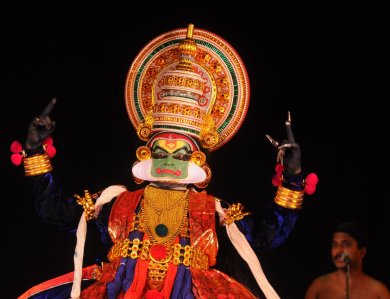
Why are the costumes so costly? Because there is carving. One carpenter takes minimum one month to carve one headgear, and then the silver and all is costly. And then another one month - minimum two to two and a half months for only headgear, and then the costumes and other things. So it is a very difficult undertaking. Then the ornaments, everything is carved wood, a special wood kumil. You can carve it in any shape. All the ornaments are made of this tree. What are the procedures of makeup and how long does it take? According to our tradition, it is only after a light dinner that you go into the green room and a lamp is lit. And then the list of dancers and characters is given out. It is only then that you know the part you have to play. Each performer's makeup takes about 3-4 hours. We apply the base ourselves and lie down, and a special makeup artist comes and does the mask-like makeup. It is not a mask that can be reused. It is proper makeup that has to be removed after each performance. The main ingredients of the makeup are minerals which are obtained from the rocks in mountains, which are also used in medicines. The yellow pigment, the red pigment, indigo - these are all pigments. This is made into powder and applied mixed with coconut oil, which soothes the skin from the burning caused by the pigment. Last year, there was a performance in Goa in winter. We had to use sunflower oil since coconut oil was not available. I had a reaction on my face, the black marks of which are still visible. It has an antiseptic effect. The pigments are added according to the desired colour, e.g., for green, we mix yellow and indigo, so the person has to be clear how much of each will determine the brightness of green. Red is also a pigment from the rock to which we add rice powder, otherwise it would be very dark. For the mask, we have 1 part chunam, quicklime, and 3 parts rice powder, which we grind with our hands. Then we mould it on drawing paper. Around 60 years back, it was done with only rice and no paper. You apply one layer, let it dry and apply the next. It was very beautiful but very delicate and the process is time-consuming. Now it is only the lining on the face, and then the paper is stuck on. It is not a mask but makeup. It will depend on the character to be depicted. For pacha characters, it will be plain, for kathi characters it is white with a red knife symbol, and the border will be with rice. For thaadi characters, it will be bigger and for Hanuman, it will be swollen too. It looks like a mask but it is not a mask. The original, in 1650 and thereabouts, was a mask. Then later, when it developed to Kathakali, in 50-60 years, 17th century onwards, it was makeup. Very few characters use masks, and not the main characters. 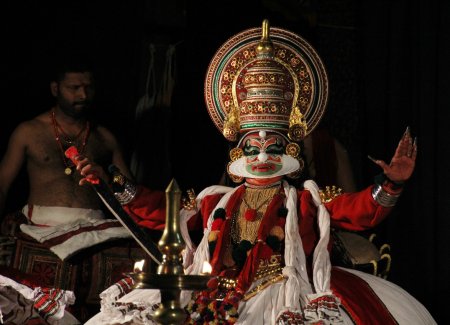 It is so elaborate - face, hair, costume is so heavy. Do you think it is a hindrance to your movement as a dancer, or does it help portray the character better? For Kathakali, it is not like other dance forms. We have our arangetram immediately after learning one small item. Then the training and performance go together. For example, I had eight years training, all those eight years I was performing. So the heavy costume becomes part of it... Now, if I'm asked to perform a character on stage without costumes, I can't do it. For us, it is very convenient. Of course it is heavy, one must admit. And those who have the experience, we have no problem performing, and that is why my guru, even when he was 90, he was performing with full costume. There are other senior gurus performing with full costumes. For those who are not familiar, it is difficult at first. For emotions etc., it helps, actually, because rasa shringara, when we perform normally, one must be very careful. But in Kathakali, it is so romantic - sometimes, it cannot be performed. In Bombay, I performed Ravana; Mandodari playing my wife, cannot be ugly because of the makeup and costume and all these things. It helps. And in normal dance forms, mainly they have shringara and not samyoga. In Kathakali, most of the performances start with samyoga, hero and heroine embracing. It never looks ugly or vulgar. Families can watch together without any problem. It helps to produce a stylized shringaram. Samyoga and vipralamba both can be presented. It helps to highlight the way we present it, but everything must be in a controlled way. What about sweat? Because of the oil makeup, the face is not affected much, and those who are not used to it, they have difficulty at first with the oil. Clothes will become wet and heavy, but the audience will not see any difference. Could you elaborate on the misuse of makeup and costumes you mentioned? I have seen a Kathakali dancer taken to invite guests into a hotel. I was very hurt, seeing such a dignified art taken to a very low commercial level. Was it a temple art? You cannot say it was a temple art. There are temple and ritual arts forms in Kerala. Kathakali is not a ritual performance. It has small rituals because of our belief in Hinduism, like lighting the lamp and blowing the conch, giving obeisance to the teacher etc. But from the beginning, it was performed outside, after the harvest in the field, in the courtyard of the landlord's house. But even in the courtyard or the field, a simple stage is all that's needed. Koodiyattam, Theyyam etc. were performed only in the temple, but Kathakali had come out fully. My message is - never use traditional art forms for commercial ads etc. I had a very bad experience going from Kozhikode airport to my home. I saw a big hoarding, up till the waist it was my picture, and then a girl with jeans below. The title was 'tradition with modernity'. Then I found out it was for a chips company. I sent a lawyer's notice but there was no address. I once saw a picture of mine that a student had taken for her own purposes, but in a brochure by someone else, with no name or credit. The costumes and makeup are so elaborate, the labour... and casually they misuse this, what can we do? Contact Sadanam Balakrishnan: spvbk@yahoo.com Post your comments Unless you wish to remain anonymous, please provide your name and email id when you use the Anonymous profile in the blog to post a comment. All appropriate comments posted with name & email id in the blog will also be featured in the site. |